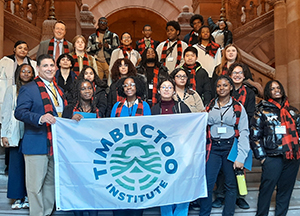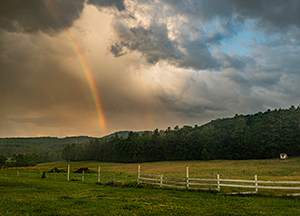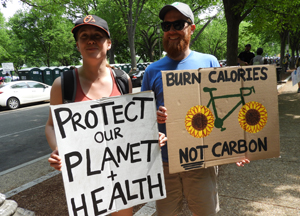
On 45th Anniversary of Earth Day, Renewed Push to Return New York to Forefront of Environmental Leadership
April 22, 2015
Long Island Exchange
(Long Island, NY) On the 45th anniversary of Earth Day, New York’s environmental and public interest community reflected on the progress made, as well as the need to return New York to its status as the national environmental leader with implementation of key policy initiatives in 2015.
Since the first Earth Day in 1970, New York has been a national environmental leader on several fronts, including:
- implementation of the State Environmental Quality Review Act (SEQR), which ensures local environmental impacts are considered before development occurs which could endanger public health.
- environmental bond acts in 1986 and 1996.
- enactment of the nation’s first acid rain law curbing emissions of sulfur dioxide and nitrogen oxides from all power plants, and the subsequent Clean Air Compliance Act of 1993.
- passage of the Bottle Bill, and subsequent Bigger Better Bottle Bill to encourage recycling of beverage containers.
- implementation of the nation’s first multi-county, private land-use plan (Adirondack Park Private Land Use and Development Plan) and multi-county planning/regional zoning board (Adirondack Park Agency).
- enactment of the Environmental Protection Fund. enactment of the Regional Greenhouse Gas Initiative (RGGI), a nine-state collaborative which reduces climate altering carbon emissions and raises funds for clean energy development.
- passage of e-waste recycling laws which reduces toxic metals and plastics disposed of in landfills.
- ban of high-volume hydraulic fracturing (fracking).
Peter Iwanowicz, executive director of Environmental Advocates of New York said, “New York has a great history of leading on environmental issues, with Republicans and Democrats alike standing up to protect our environment and public health. Yet the greatest challenges are ahead of us, particularly on climate change and public health issues. New Yorkers have the right to know what’s going into their food and kid’s products. They have the right to clean drinking water and sewer systems that work. We need champions in state government, and are looking to Governor Cuomo and legislators to continue our state’s environmental leadership.”
2015 Environmental Agenda
Climate Action Plan/No More Raids
President Barack Obama has called climate change the greatest threat to the next generation. Governor Cuomo has pledged to reduce the carbon emissions driving climate change 80 percent by 2050. Yet, New York State has yet to implement an economy-wide climate action plan. In fact, in this year’s state budget, the Governor and legislators took a step backwards and swept $41 million from the state’s only carbon cap program – RGGI – and redirected it to the state’s General Fund for non-carbon abatement purposes. We need state leaders to take sides on climate change, finally enact New York’s climate action plan for all sectors of the economy, and pledge to support programs like RGGI, not undermine their progress with poorly devised raids.
Blair Horner, legislative director at NYPIRG said, “While it may seem hard to believe after this brutal winter, the planet is heating up. 2014 was the hottest in recorded history. If nations are to mitigate the damage from this global warming, they must heed the world’s experts’ advice and reduce greenhouse gas emissions by 80 percent by the year 2050. New York can help lead the way by mandating a plan to meet that goal. We urge action on Assemblyman Englebright’s bill.”
Child Safe Products Act
A lack of federal oversight of the chemical industry means that kid’s products like toys and bedding are made with notorious toxins such as arsenic, mercury and lead. This common-sense legislation, which would ban the sales of children’s products made with the most egregious chemicals, enjoys strong bipartisan support. In 2013, the bill had 37 cosponsors, and 40 in 2014; only 32 votes are needed for passage. While it has passed overwhelmingly in the Assembly, it has never received a Senate vote.
Children are more susceptible to the harmful effects of smaller amounts of chemicals than adults, due to their developing systems. Leukemia, brain cancer, and other childhood cancers have increased by more than 20% since 1975, according to a 2011 report released by the Environmental Protection Agency, America’s Children and the Environment: Measures of contaminants, body burdens, and illness. A 2005 study of industrial chemicals conducted by a non-profit research based organization, the Environmental Working Group, detected 287 chemicals and pollutants in umbilical cord blood, 180 of which cause cancer, 217 are toxic to the brain and nervous system, and 208 cause birth defects or abnormal development in animal tests.
Senator Phil Boyle (R-Bay Shore), lead sponsor of the Child Safe Products Act (S4102) said, “I can think of no better way to celebrate Earth Day than to reaffirm my goal of protecting children from toxic chemicals. Despite market advancements and announcements by major retailers, voluntary measures just don’t get us there. It’s up to us, as elected officials, to take action to protect New York’s most vulnerable residents. With Assembly passage imminent and over half the state Senate cosponsoring the bill, I am even more committed to seeing it enacted in 2015.”
Kathy Curtis, executive director of Clean and Healthy New York said, “Most parents find it shocking that toxic chemicals are routinely added to common, everyday products, even those
made for our children. People find it even more shocking to hear about how hard it is to get a law passed to cease this dangerous practice. As we celebrate the 45th anniversary of Earth Day, let’s all agree that it’s time to put an end to toxic chemicals in children’s products, and that this is the year to pass the Child Safe Products Act.”
GE Food Labeling
Much of the developed world has taken steps to empower consumers with the ability to make informed choices by labeling genetically engineered (GE) food products offered for retail sale. Some 64 countries, including all of the European Union and key trading partners such as Russia, Brazil, Japan, and China, already require GE food (aka “GMOs”) to be labeled as such.
The mass adoption of genetically engineered crops in the U.S. in recent decades has resulted in a massive increase in herbicide usage, as the seeds were engineered to withstand sprayings with the weed killer glyphosate. This has resulted in the emergence of glyphosate-resistant weeds, and the return to the use of other toxic herbicides such as 2,4-D (one of the active ingredients of Agent Orange) and dicamba. Glyphosate usage has led to the decimation of the Monarch butterfly and has negatively impacted soil health. Glyphosate (trade name: Roundup) was recently classified as “probably carcinogenic to humans” by an agency of the World Health Organization; it has been detected in food and water, and in air during spraying. Glyphosate has also been found in the blood of pregnant women and their fetal umbilical cords, and in the blood and urine of agricultural workers.
Dr. Michael Hansen, senior scientist with Consumers Union, the policy and advocacy arm of Consumer Reports said, “The recent reclassification of the herbicide glyphosate – used on virtually all GE crops – as a probable human carcinogen underlines the need to pass a mandatory GE labeling law, so consumers can make an informed choice about eating such foods.”
Community Clean Water Infrastructure Investments
Statewide, communities are on the hook for at least $36 billion in unmet wastewater infrastructure needs, including 61 of 62 counties that have identified projects requiring $12.7 billion in immediate financial need. Drinking water infrastructure projects are estimated to cost tens of billions more. The Office of the Comptroller says there is an $800 million budget gap for these needs each year. The coalition is urging legislative leaders to work with Governor Cuomo in the final weeks of negotiation to deliver these funds in the enacted budget.
The current state budget provides $50 million in matching funds available to municipalities for their upgrades, and $75 million in each of the next two budgets. Now that the program for including drinking water and sewer investments is part of the state budget, it should be standard operating procedure every year to identify need and invest in our communities’ drinking and sewer systems. Our needs are enormous and growing, and advocates are urging ongoing investments at the levels needed to protect public health, our environment, and facilitate true economic development.
Jessica Ottney Mahar, director of government relations for The Nature Conservancyin New York said, “Clean and abundant water is one of New York’s most treasured natural assets and it is significant that this year’s budget included new funding to reduce pollution and protect clean water for future generations. The Nature Conservancy thanks Governor Cuomo and the state Legislature for taking this important first step towards addressing the need for water infrastructure funding.”
Crude Oil
The nationwide volume of crude oil transported by rail has increased to more than 832,000 carloads in 2014 compared to 9,500 carloads in 2008. Huge amounts of crude oil is increasingly being transported along railways from production fields in the mid-western United States and Canada to ports including Albany for transfer to barges and ships to be transported on the Hudson River to East Coast refineries. In fact, as much as 25% of the highly volatile crude oil extracted from the Bakken formation is transported through New York State communities.
The State Fiscal Year 2015-2016 budget includes an increase in the fees oil companies will pay into the Oil Spill Fund and, for the first time, allows a small portion of the fund to be used to assist communities in their preparation for spills or catastrophic oil train derailments. But, there is still enormous risk associated with the oil-by rail and oil-by barge industry that is taking root in New York. With huge risk and no reward, New York must require companies moving crude oil through the state to have insurance to cover against what could be billions in clean up and damage mitigation expenses.
Adirondack Council Executive Director William C. Janeway said, “Oil trains threaten the clean water, wilderness and communities of the Adirondack Park every day, as they carry millions of gallons of explosive crude oil over more than 100 miles of track along the edge of Lake Champlain. Any accident involving an oil spill or explosion would be a tragedy to our people, our drinking water and New York’s rarest and most sensitive wildlife habitat.”
Microbeads Ban
Microbeads, tiny plastic balls used in products such as shampoo and toothpaste, cannot be filtered out of the water supply by sewage treatment plants. Likewise, they cannot be controlled before going into local waterways and ultimately the food chain.
In addition to being harmful to the environment, microbeads accumulate other toxic chemicals, including PCBs, DDTs, and flame-retardants. Fish and other aquatic organisms, including birds and invertebrates, have long been shown to ingest microplastics. Once ingested, the chemicals can be passed up the food chain to larger fish, wildlife and ultimately humans
Attorney General Eric Schneiderman has proposed legislation that would prohibit the production, manufacture, distribution and sale in New York of any beauty product, cosmetic or other personal care product containing plastic particles less than 5 millimeters in size.
Kate Hudson, special projects director at Riverkeeper said, “We urge the legislature to take action to keep New York on the forefront of combating plastic pollution in our precious waterways by passing the Microbead Free Waters Act. The Attorney General’s recently released report confirms that these tiny plastic abrasives are passing through wastewater treatment plants to waterbodies across the state, including the Hudson River, leading to contamination of fish and wildlife, potentially moving up the food chain to humans. Banning the use of microbeads will hasten an industry shift to safer, natural alternatives that already exist and stop this harmful plastic contamination of New York waters which could be completely avoided if prompt legislative action is taken.”





